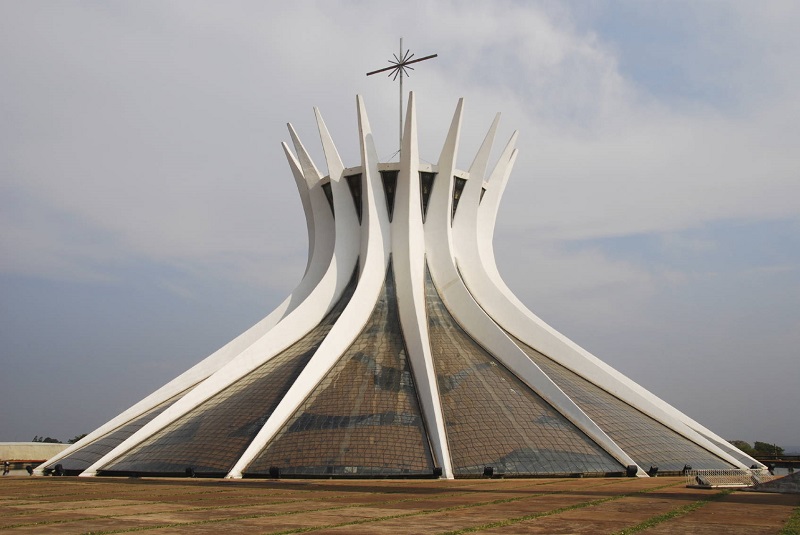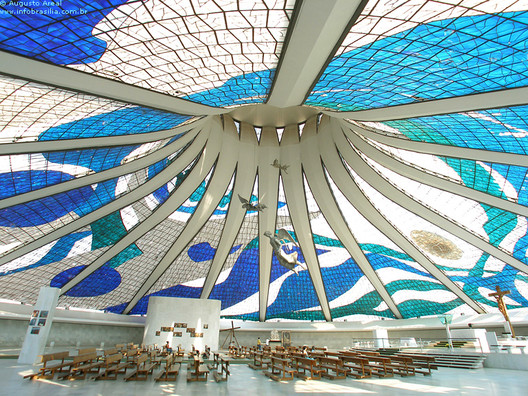Cathedral of Brasilia
The Cathedral of Brasilia is a Roman Catholic cathedral which serves as the seat of the Archdiocese of Brasilia. It is one of many public buildings in the Brazilian capital which were designed by the architect Oscar Niemeyer. Niemeyer’s intention was to create a volume that has the same ‘purity’ from any perspective.
The cathedral is a hyperbolic structure built from concrete. It measures 40 m in height and is capable of holding up to 4,000 people. The base is circular and measures around 60 m in diameter.
The structure, with its glass ceiling, is supported by 16 curved steel columns which weigh 90 tonnes each. The large stained glass windows are shaped into triangles that fit together between the columns. The windows measure 30 m high and 10 m across at the base.
The cathedral’s bell tower houses four bells that were donated by Spain. Inside the nave, three sculptures of angels are suspended by steel cables. These range in size from 2.22-4.25 m in length and weigh 100-300 kg each.
The foundation stone was laid in 1958 and the building was completed in May 1970. Since then, it has become a popular tourist attraction and an iconic symbol of Brasilia.
[edit] Related articles on Designing Buildings Wiki
- Brazilian Modernism lecture.
- Cathedral.
- Durham Cathedral's Open Treasure project.
- Floors of the great medieval churches.
- Florence Cathedral.
- Heddal stave church, Norway.
- Lotus temple.
- Maracana Stadium.
- National Library of Latvia.
- Niteroi Contemporary Art Museum.
- Notre Dame du Haut.
- Sagrada Familia.
- St. Basil’s Cathedral.
- St. Paul’s Cathedral.
- St. Peter’s Basilica.
- Unusual building design of the week.
Featured articles and news
RTPI leader to become new CIOB Chief Executive Officer
Dr Victoria Hills MRTPI, FICE to take over after Caroline Gumble’s departure.
Social and affordable housing, a long term plan for delivery
The “Delivering a Decade of Renewal for Social and Affordable Housing” strategy sets out future path.
A change to adoptive architecture
Effects of global weather warming on architectural detailing, material choice and human interaction.
The proposed publicly owned and backed subsidiary of Homes England, to facilitate new homes.
How big is the problem and what can we do to mitigate the effects?
Overheating guidance and tools for building designers
A number of cool guides to help with the heat.
The UK's Modern Industrial Strategy: A 10 year plan
Previous consultation criticism, current key elements and general support with some persisting reservations.
Building Safety Regulator reforms
New roles, new staff and a new fast track service pave the way for a single construction regulator.
Architectural Technologist CPDs and Communications
CIAT CPD… and how you can do it!
Cooling centres and cool spaces
Managing extreme heat in cities by directing the public to places for heat stress relief and water sources.
Winter gardens: A brief history and warm variations
Extending the season with glass in different forms and terms.
Restoring Great Yarmouth's Winter Gardens
Transforming one of the least sustainable constructions imaginable.
Construction Skills Mission Board launch sector drive
Newly formed government and industry collaboration set strategy for recruiting an additional 100,000 construction workers a year.
New Architects Code comes into effect in September 2025
ARB Architects Code of Conduct and Practice available with ongoing consultation regarding guidance.
Welsh Skills Body (Medr) launches ambitious plan
The new skills body brings together funding and regulation of tertiary education and research for the devolved nation.
Paul Gandy FCIOB announced as next CIOB President
Former Tilbury Douglas CEO takes helm.
UK Infrastructure: A 10 Year Strategy. In brief with reactions
With the National Infrastructure and Service Transformation Authority (NISTA).
























